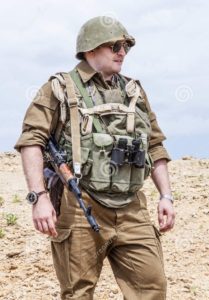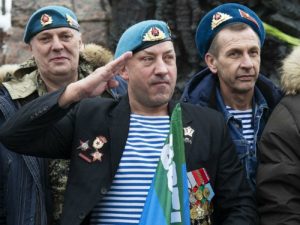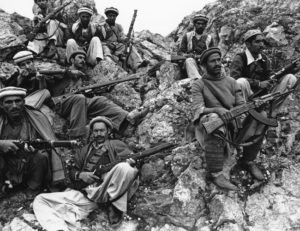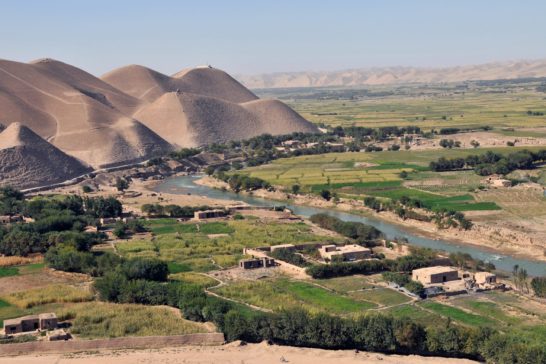The Soviet Union invaded Afghanistan in 1979 and withdrew in defeat in 1989. Over that decade, millions of Afghans were driven from their homes, between 1/2 million and 2 million Afghan civilians were killed, and the Soviets officially recorded about 13,500 combat deaths and some 53,700 wounded in combat.
The war is not well understood by Americans. When the Soviets invaded Afghanistan, they didn’t intend to conquer it, or plan to annex it to the USSR; their aims were more limited. In fact, the invading force was officially called the “Limited Contingent of Soviet Forces in Afghanistan” to emphasize its limited mission. The name was not a sham; it reflected the Soviets’ real intentions. Their intent was to prop up a friendly government and rescue a faltering communist revolution, and their military effort was well short of an all-out commitment.
 Soviet leaders tried to hide the fact their troops were fighting at all. Initially, they used conscripts from their “Stan” provinces, but that didn’t work out, so they eventually sent Russians. They told the Soviet public the troops were sent there to “build schools and plant trees,” and tried to sneak the coffins home in the dead of night. But the propaganda and other ruses employed to cover up the fact the Soviet Union was fighting a war didn’t fool the Soviet people, and the war quickly became unpopular on the homefront.
Soviet leaders tried to hide the fact their troops were fighting at all. Initially, they used conscripts from their “Stan” provinces, but that didn’t work out, so they eventually sent Russians. They told the Soviet public the troops were sent there to “build schools and plant trees,” and tried to sneak the coffins home in the dead of night. But the propaganda and other ruses employed to cover up the fact the Soviet Union was fighting a war didn’t fool the Soviet people, and the war quickly became unpopular on the homefront.
This would have consequences for the troops sent to fight (called “Afghantsi”) similar to those endured by Americans who fought in Vietnam, only worse. They were unceremoniously dumped back into Soviet society, then shunned by their neighbors, and virtually abandoned by their government. Most were conscripts obligated to serve two years, most of which was spent in the war zone after a few weeks of inadequate training.
The Soviet-Afghan War has often been compared to the Vietnam War, but it was a smaller war in terms of forces (about a third of the U.S. troop strength in Vietnam) and intensity of fighting (mostly lower key). It did have similar political objectives, in that it was fought ostensibly to prop up an ally, although the underlying motivations were more complicated.
Afghanistan bordered the USSR’s southern provinces, which were forcibly annexed by Stalin in the 1920s. This is a Muslim region, and the Kremlin worried about potential unrest there. It’s no coincidence the Soviets invaded Afghanistan in the same year of the Iranian revolution. The events in Iran undoubtedly stoked Kremlin paranoia about Muslim restlessness, and this was a factor in the decisions made. However, Soviet aims were limited to preserving up a friendly Kabul regime. A CIA belief that Moscow eyed using Afghanistan as a springboard to seize the Persian Gulf and world oil supply was baseless. However, it would play an important role in the war, because it was part of the CIA’s motivation for supplying and supporting the Afghan resistance.
Parenthetically, it should be remembered that Iranian and Afghan Islam aren’t the same. Iran is primarily Shiite, while Afghanistan is mostly Sunni. You probably know Islam has two major branches, similar to Christianity’s division into Catholics and Protestants (although the analogy shouldn’t be carried too far). In addition, because of geographical isolation, Sunni Islam evolved differently in Afghanistan than elsewhere, but should be thought of as a distinctive denomination within Sunni Islam rather than a third branch of Islam.
 During the 1950s, the Soviet Union provided aid projects, such as dams and roads, in Afghanistan and trained Afghan Army officers. Of course, the Moscow-trained officers were indoctrinated in Soviet communism. However, when the monarchical central government of Afghanistan was overthrown in the spring of 1978 by the “Saur revolution,” middle-ranking Afghan army officers only provided the muscle; the coup was led by civilian communist intellectuals based at Kabul University. (Here it should be remembered that actual governing in Afghanistan was very decentralized; the country’s leader often was jokingly referred to as “the mayor of Kabul.”)
During the 1950s, the Soviet Union provided aid projects, such as dams and roads, in Afghanistan and trained Afghan Army officers. Of course, the Moscow-trained officers were indoctrinated in Soviet communism. However, when the monarchical central government of Afghanistan was overthrown in the spring of 1978 by the “Saur revolution,” middle-ranking Afghan army officers only provided the muscle; the coup was led by civilian communist intellectuals based at Kabul University. (Here it should be remembered that actual governing in Afghanistan was very decentralized; the country’s leader often was jokingly referred to as “the mayor of Kabul.”)
This group was divided into two factions, who didn’t get along, and in the fall of 1979 the leader installed by one faction was assassinated on orders of the other faction’s leader, who took over. He got too big for his britches and a bit sassy with Brezhnev, and when the Kremlin decided to invade Afghanistan in December 1979, they sent Russian commandos to the Kabul’s presidential palace to kill him. The Soviet invaders then installed an Afghan who was essentially a Moscow puppet, and from then on the Soviet occupiers ran the show. They also ended up fighting the war largely by themselves, because the Afghan army was ineffective and suffered a very high desertion rate.
The Afghan communists were brutal. They were also profoundly unpopular. They were urban intellectuals who wanted to revolutionize Afghan society in ways that grated on the very conservative, very religious, and very traditional rural populace. They wanted to develop the country economically, and alter society to its foundations, including sending girls to school, which was anathema to Afghanistan’s fundamentalists who dominated Afghan society outside the cities. Only in Kabul did girls not wear burkhas and attend schools.
In traditional Afghan rural society life centered on clan and village, marriages were arranged, and life was hard. Typically 40% of children died before age 5, and the average adult lifespan was 42 years. Nearly all rural Afghans were illiterate; often the village imam was the only person who could read, and solely for the purpose of instructing from the Quran. Rural Afghans recognized private land ownership; and when urban-based communists attempted land redistribution, the peasant farmers considered it stealing and forbidden by their religion.
While land itself was abundant and free for the taking, it was useless for agriculture without irrigation, which depended on complex systems built by hand labor over many generations, because most of Afghanistan gets very little rainfall and needs river water to grow crops. The rivers are fed by snowmelt coming down from the mountains that split Afghanistan into northern and southern regions. Virtually the entire value of a farming plot lay in the irrigation system; the land was worthless without it. During the war, the Soviets drove civilians off the land by, among other things, bombing and blowing up irrigation systems.
Villages were isolated; Afghanistan had hardly any roads, and only one major one, called the “Ring Road,” connecting the major cities in a giant loop within the country; and no railroads at all. This was of major strategic importance, because the guerilla war was fought almost entirely against the Soviet supply convoys coming down the Salang Highway, the only north-south road artery, and the Ring Road connecting Kabul with the other cities.
It was the Afghan regime and army, not the Soviets, who provoked the uprising by brutalizing the population and trying to force changes the people didn’t want. They did things like machine-gunning high school girls protesting in Kabul, and carting off imams and village leaders to the notorious Pul-e-Charkhi prison near Kabul to be tortured and murdered.
 The civilians reacted as you would expect. The organized resistance consisted of seven major groups, four of them Islamic, and three more or less secular. This is important, because they didn’t get along, and sometimes would even fight each other. These groups were based in Pakistan and staged raids across the border. They traveled light and fast, usually at night, carrying only weapons and relying on villages along the way to feed and shelter them. This enabled the mujahedeen to march from the border to the Salang Highway in two or three days, attack the convoys, then retreat back to Pakistan and regroup for the next raid. Donkeys and rugged Afghan ponies provided heavy transport for machine guns, mortars, and rockets. The mujahedeen also used weapons captured from the Soviet and Afghan armies.
The civilians reacted as you would expect. The organized resistance consisted of seven major groups, four of them Islamic, and three more or less secular. This is important, because they didn’t get along, and sometimes would even fight each other. These groups were based in Pakistan and staged raids across the border. They traveled light and fast, usually at night, carrying only weapons and relying on villages along the way to feed and shelter them. This enabled the mujahedeen to march from the border to the Salang Highway in two or three days, attack the convoys, then retreat back to Pakistan and regroup for the next raid. Donkeys and rugged Afghan ponies provided heavy transport for machine guns, mortars, and rockets. The mujahedeen also used weapons captured from the Soviet and Afghan armies.
This civilian connivance with and support for the resistance was a major motivating factor in Soviet efforts to empty the provinces bordering Pakistan of civilians. This became essentially a genocide, and to hide it, the Soviets tried to keep Western journalists out of Afghanistan. In one instance, they targeted and killed an American journalist traveling with a mujahedeen group. But these efforts were ineffective, and there’s a substantial body of war correspondent coverage of the war available in English-language books. Medicins Sans Frontieres (Doctors Without Borders) were also active in Afghanistan, and the Soviets bombed their hospitals.
In attacking Soviet supply convoys, the mujahadeen often positioned on cliffs above the roads, where they had good cover, and typically were armed with vintage bolt-action rifles, such as British Enfields or copies, which outranged the Soviets’ modern assault rifles, allowing them to engage convoy guards who couldn’t effectively return fire; a good Enfield-pattern rifle could shoot to 1,000 meters, while the Soviet Army’s standard-issue AK-47s weren’t much good farther than 400 meters. This made the convoys relatively easy pickings for the mujahedeen; all they had to do was get there from their sanctuaries in Pakistan, although that could be problematical at times after the Soviets began stepping up their interdiction efforts.
 Strategies and tactics evolved throughout the war. The Soviets brought in bombers and attack helicopters, mostly based a Bagram Air Base near Kabul, which later became a major American base. These had their effect, but more important to the war effort was the deliberate clearing of the Afghan civilian population, by violent means, from the provinces bordering Pakistan in order to deprive the mujahedeen of their civilian support infrastructure. Most of these refugees ended up in large camps in Pakistan. Many had relatives there. But even after the farms and villages were destroyed, and the civilians run off, the fighting never let up. The mujahedeen simply adapted to the changed situation.
Strategies and tactics evolved throughout the war. The Soviets brought in bombers and attack helicopters, mostly based a Bagram Air Base near Kabul, which later became a major American base. These had their effect, but more important to the war effort was the deliberate clearing of the Afghan civilian population, by violent means, from the provinces bordering Pakistan in order to deprive the mujahedeen of their civilian support infrastructure. Most of these refugees ended up in large camps in Pakistan. Many had relatives there. But even after the farms and villages were destroyed, and the civilians run off, the fighting never let up. The mujahedeen simply adapted to the changed situation.
When Gorbachev came to power in 1985, he gave the top general in Afghanistan a year — and a free hand — to wrap up the war, which he referred to as a “bleeding wound.” The worst Soviet abuses occurred during this period. A major strategy at this point was to shift responsibility for the war to the Afghan army, which was manned by poorly trained conscripts who deserted if they could. As a result, the Afghan army wasn’t an effective fighting force. When that effort failed, the Soviets cobbled together an exit plan, and withdrew the last of their troops in February 1989.
The CIA provided significant financial and material support to the mujahedeen, but had to funnel it through Pakistani authorities, who siphoned off some of it and directed the rest to the resistance groups they favored. So the U.S. had little control over this aid or who got it, which accounted for the American reluctance to supply sophisticated weapons like the Stinger anti-aircraft missile. The most famous of the mujahedeen commanders, Ahmad Shah Masud or Masood (who was assassinated by the Taliban 2 days before the 9/11/01 attacks), got virtually none of this aid and fought with Afghan weapons and those his fighters could seize from the Soviets.
There’s a popular belief in America that CIA-supplied Stinger missiles won the war. This isn’t true. In the mid-1980s the resistance was faltering, and might have collapsed without foreign support (which also came from Saudi Arabia and other countries), but the Stingers came later, after the mujahedeen had revived and were again carrying on a vigorous war against the Soviet occupation forces. They were introduced late in the war, by which time the Soviets had already decided to pull out, and they were only effective to force Soviet fighter-bombers and helicopters to fly above 10,000 feet, which deprived the ground troops of close air support — a painful loss of military advantage, but not a critical one. The Soviet troops still had substantial tank, armored vehicle, and artillery assets in support of their infantry operations.
In hindsight, the war should be considered a miscalculation. The Soviet leadership underestimated the belligerence and tenacity of the Afghan people. The Afghan communists wrongly believed they could change a very traditional society, in which culture and customs (not to mention religion) were deeply ingrained, by brute force. The goals of the Afghan communist revolutionaries were never achievable. The outside support the mujahedeen received, together with sanctuaries in Pakistan, was essential to an effective resistance, but the Afghan people probably never would have been subdued under any circumstances. While those sanctuaries were disadvantageous for the Soviets, they never considered expanding the war into Pakistan. Their objectives were always limited, and when it became apparent those objectives couldn’t be achieved, and faced with mounting costs, they made the decision to pull out. The Afghan regime survived on its own for a few more years before being displaced by the Taliban.
The Taliban who eventually fought Americans were, in many cases, orphans of the Soviet-Afghan War who were raised and indoctrinated by imams in madrasses in the Pakistani refugee camps — a parting gift of the Soviet invaders to their American counterparts who came later.
Return to The-Ave.US Home Page
Video below: Russian Afghan war song “Karavan.” Russian soldiers liked folk-type guitar music with plaintive lyrics capturing the essence of their trials and hardships.
